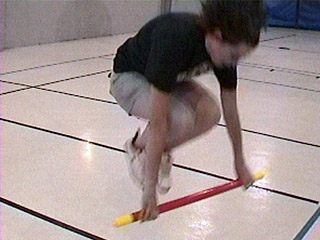Activity 20: Solo High Jump



Solo High Jump Activity
Activity Plan
Group Size: 1 at a time
Time: 5 - 10 minutes
Mental Intensity: 1
Physical Intensity: 3
Space: Minimal
Objectives
- Brainstorm and share strategies to jump over the tube
- To push each individual to his or her personal limit
- Discuss the experience and feelings
Character Focus
Uniqueness
Preparation
Time: None
Materials:
1 long Toobeez per person
1 envelope
chart paper (optional)
Setup:
- Place the Risk Taking Note into an envelope.
- Provide each person with a long Toobeez tube.
The Challenge
Each participant will jump over the tube.
Safety Reminders!
Appropriate caution is important to conduct these activities in a safe manner. Be sure to review these reminders prior to beginning the activity, and if necessary, share reminders with the group during the activity.
- Follow general safety procedures
- This activity is dangerous no matter how you look at it. The person jumping can easily hurt themselves in a number of ways
- Out of each group of ten average people, there is usually one who can successfully jump the tube. The others who are watching this one successful person might be tempted to jump even though, deep down, they know they should not
Helpful hints
- Don’t offer this activity if you are concerned about someone getting hurt
- Even though it’s dangerous and tricky to do, this is a fun activity with a lot to offer in terms of debriefing
Activity Instructions
- Circle up the group. Distribute or display the appropriate “Risk Taking Note” for the activity. Have one participant read it aloud twice. Provide a few moments for the participants to think about the message:
“Our lives improve only when we take chances, and the first and most difficult risk we can take is to be honest with ourselves.” - Walter Anderson. - Share the following storyline with group.
This is your big Olympic trial for the Solo High Jump! You can do it! - Read aloud the following Activity Challenge Box to the group.
Challenge: Each participant will jump over the tube. Follow the guideline below:- During the jump, the jumper must hold onto the tube with both hands at all times
- Before the participants attempt an activity challenge, have the group work through the following six steps:
- Circle up
- Know and understand the challenge and the guidelines
- Brainstorm
- Make a plan
- Do the plan
- Evaluate results and adjust as necessary
- For the forward jump, the jumper stands holding the tube in their hands in a horizontal fashion. The tube starts out in front of them and will end up behind them.
- Be sure to monitor each participant for safety as he or she attempts the activity.
- If participants get stuck, have the students circle up again. Here are some suggested questions to help guide the group back on track*:
- What is working?
- What ideas have you not tried yet that someone suggested?
- If your group is still struggling OR if you feel your group would benefit from an additional challenge, present a variation provided on the next page.
- After the activity, move to the debriefing questions for discussion.
Problem Solving Sequence:
Activity Variations
- Jump backward.
Start with the tube behind you and end up with the tube in front of you. - Close your eyes.
If you really want to test your coordination, jump forward with your eyes closed. Save yourself some time, and dial 911 before you attempt this.
Debriefing the Activity
Use these debriefing questions as a guide for your discussion. Select the questions you feel will best benefit your group. It is not mandatory to cover every question. If possible, record the group’s responses on flip chart paper so all comments are displayed. Make sure to let everyone share their ideas, and remind participants that everyone’s opinions and feelings are important!
Base questions for debriefing:
- What did you just do?
- Did you attempt to jump the tube? Why or why not?
- How did you feel while you did the activity?
- What was one of the challenges of doing this activity?
- What did the group have to do or believe to be successful?
- How can you apply what you learned in this activity to your life and work?
If the group was unable to complete the task in the given time:
- How do you feel now?
- If you were not able to jump over the tube, does that make you a failure? (Really push the group and point out the learning, do not let them answer this question with a yes or no answer-push them to explain and discuss)
Additional questions: Choose which ones are the most appropriate:
- What was one positive thing that happened during the challenge?
- How do you work to keep improving your work with others?
- Did you try different ideas? If so, why did you change your approach?
Close on a Positive Note
Sum up the different ideas and feelings that you heard expressed, and restate ideas and learning moments the participants shared. Then, read the Risk Taking Note out loud again, and ask people to discuss what they think this note means. Discuss what they thought it meant at the beginning and what they think it means now.
* (ˆ) Do not provide the participants with answers. Allow them to work together.





